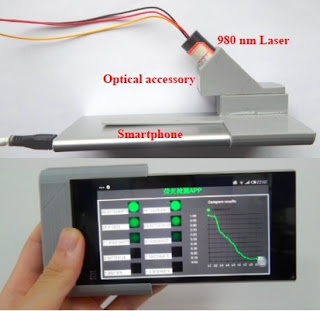Health
New technology uses Smartphones and Paper to Detect Harmful Pesticides

Pesticides are used to keep bugs off of your food while it grows. The major downside is that the pesticides on your food can be harmful and toxic to your health. Unless you eat organic food that hasn’t come into contact with other produce you may want to check out a food analyzing technology to see how toxic it is before you buy it.
New Technology that can be Analyzed by a Smart Phone!
According to a study published in Biosensors and Bioelectronics, this awesome new technology allows you to use paper sensors that are able to analyze your food using an Android program. The system will help you detect harmful toxins quickly and cheaply!
 The more we learn about pesticides and their effect on our health the more we are looking for alternative food sources and new technologies to keep our food safe. What makes this such an uphill battle is the fact that traditional pesticide scanners can be very expensive and take a while to process the data. In the past, if you were expecting a quick cheap scan of your food you would be out of luck.
The more we learn about pesticides and their effect on our health the more we are looking for alternative food sources and new technologies to keep our food safe. What makes this such an uphill battle is the fact that traditional pesticide scanners can be very expensive and take a while to process the data. In the past, if you were expecting a quick cheap scan of your food you would be out of luck.
Smaller detectors have been created in the past that will use paper as a sensing material, but, unfortunately, they weren’t strong enough to sense the chemicals.
According to this awesome new study from the National University of Singapore with the Hefei University of Technology in China, they have developed a portable detection system with a simple paper sensor that will work with your smartphone. The new technology will allow a simple paper sensor to pick up the signals and detect pesticide residue on our produce.
“Since detectors are usually big, it was important that we could develop a smaller unit that was powerful enough to detect small concentrations of the pesticide,” said Prof. Qingsong Mei.
“We’re excited that this new detection system works to identify thiram, and we think we can develop it further to detect many different molecules in a sample,” added Prof. Yong Zhang another author on the study.
How they made this awesome New Technology!
In order to make the sensitive detector, the researchers broke it down into three components. They use nanoparticles to shine a fluorescent signal on the paper to detect the pesticide. Then they used a 3D printed piece of equipment made from a smartphone which they attached to a mini-laser. They also used a mini-cavity and an optical filter to read the data.
The last piece to the puzzle was to create android software that would quickly analyse the light particles and determine if there were toxins on your food.
How it works.
The specialized paper is covered in copper ions, so when a sample is put on the paper the pesticide molecules will attach to the copper ions. The device will then shine a light onto the copper ion paper and pick up the data with the optical filter.
The Smartphone software will then read the data based on the light that was emitted from the nanoparticles on the specialized paper.
“This is one of the first prototyping systems that integrates a paper sensor like this with a smartphone, and it can be reused, making it economically even more favorable,” said lead study author Prof. Bing Nan Li. “The smartphone is advantageous in terms of its portability, accessibility, programmability, ease of use and low cost; it brings revolutionary opportunities to the analytical community.”
I know this sounds like a complicated system, but it is actually something that could be done very quickly. Perhaps with big breakthroughs like this the smartphones of the near future will all be equipped with awesome pesticide detecting technology.
Other Uses of this New Technology.
There are definitely other uses for this type of nanotechnology. You could use it to detect pretty much any type of molecule. For example, in medicine it could be used to quickly identify harmful toxins, drugs, antibodies or proteins. This might make it much cheaper to do home medical tests and have a much quicker diagnosis of the problem.
“We’re now making the system useful for real-world application,” said Prof. Zhang. “We’re planning to use the technology to detect multiple molecules at the same time — something called multiplex detection. In this way we could, for example, test the quality of the food we eat every day.”
The technology is still in the prototype phase and until it is widely available it is still probably safest to get your food from local and organic sources. There is a huge difference in the level of toxins in your body when you only eat organic.
Check out what happens when this family eats only organic for a week!
Image Source: marighttoknow.com
Typos, corrections and/or news tips? Email us at Contact@TheMindUnleashed.com
